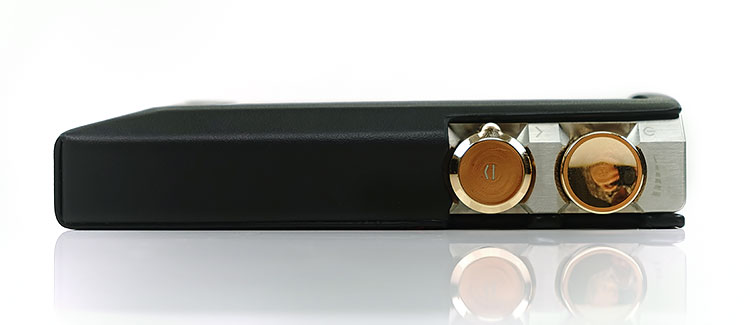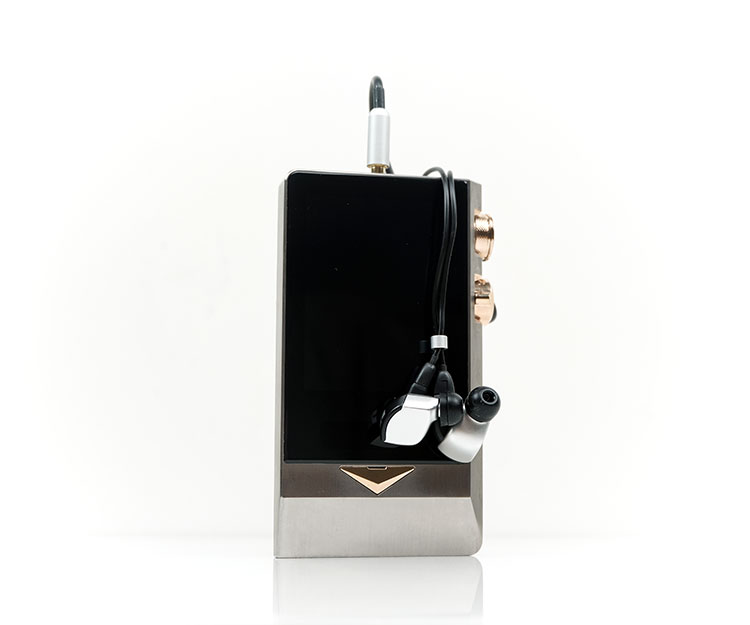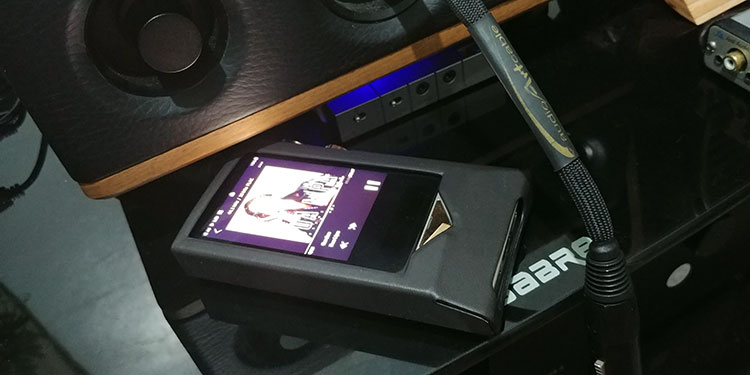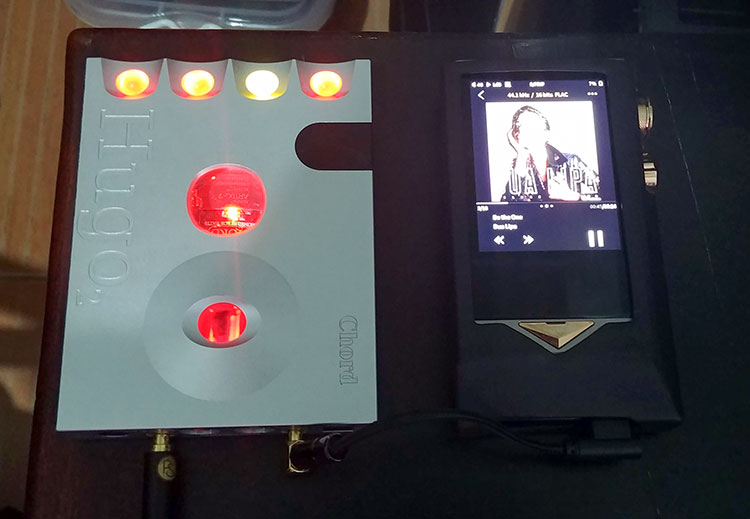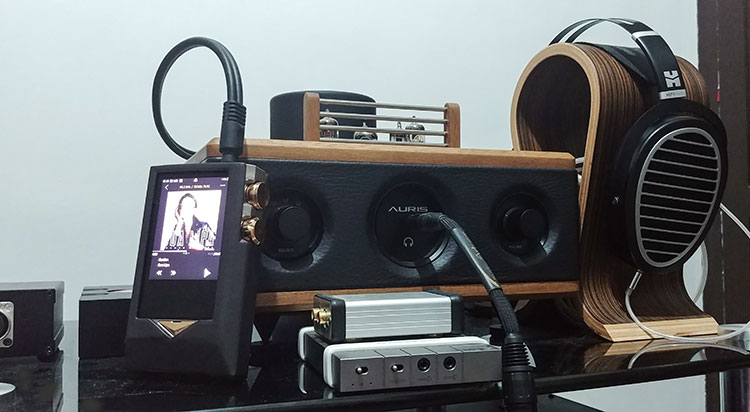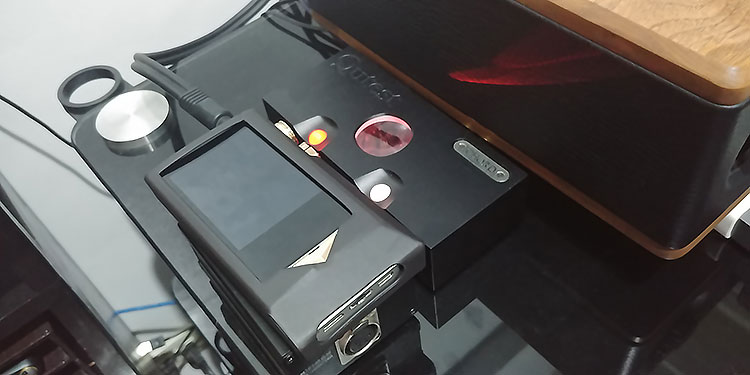Sound Impressions
Tube Output
I just love the tonality of the tube output on the N8. I would not go as far as to say its the equivalent of a set of Brimar black cap 6V6’s stuck on the front panel but it is unmistakably smooth, lush and ‘gentler’ in its delivery than its solid-state unbalanced alternative.
Of late I have been seeing desktop headphone tube manufacturers aim for something like a middle ground in their tube presentatio9ns. Companies such as Feliks and Auris have retained that analog signature but subtly nudged the listener to a more neutral sound to grab those who may have a preference for reference-type listening.
Presentation
The N8 Nutube tonality doesn’t quite go that direction but neither is it too flabby and slow-paced either. Instead, you get a healthy injection of even-harmonic bias, additional low-end to lower-midrange warmth and a very rich but detailed level of texture in its instrumental timbre.
In short, its analog sounding and delivers an amazingly engaging experience with rustic rock vocals such as Steve Earle and Myles Kennedy. And yes, in case you are asking Led Zep recordings sound as they damn well should with the N8’s tube output delivering a decidedly analog sound.
Delivering on the ‘Vibe’
The dynamic range of the tube output is excellent so it is not one-paced either. Summery-vibe electro-synth melodies deliver both a “fatness” to its notes but enough spritely pace and impact to sound engaging rather than boring.
I have been listening to a lot of Kevin Montgomery of late. This is the musician behind modern synth-wave bands such as SelloRekT /LA Dreams which deliver some fantastic mid-paced dance stuff. Their Avenue Electric album, in particular, is one of my favorites. Tracks such as Heather are tailor-made for the tube output of the N8. It invokes that analog almost vinyl-like 80’s vibe which I think is essential to enjoying tracks like this.
Solid-State Output
Clarity & Aggression
The solid-state will sound the punchier of the two amp stages with an impactful but drier low-end sound compared to the smoother more laid-back tube performance. The solid-state output will deliver a cooler timbre than the tube output and a little more odd-harmonic emphasis also. Those who enjoy a cleaner sound with precise instrumental control will likely gravitate to the N8’s SS output.
That is not to say this is a neutral or analytical experience compared to the tube analog flavor. I still get that AKM vibe in the presentation from the Cayin N8. The low-end is elevated, powerful and forward, the vocal presence is focused and the lower treble has plenty of energy.
During our testing, I tended to prefer the solid-state output for complex instrumental arrangements where I need the N8 to deliver every ounce of tightly controlled detail it can muster, particularly in the low-end. Harder pumping EDM or arena rock where I need aggression but at the same time a very high level of instrumental clarity better suits the N8 solid-state experience.
Grungy Control
Switching to solid-state does increase the ‘bite’ in the N8’s timbre but takes a little soul and analog smoothness away compared to the tube output. For solid-state I have other music as my preference to take advantage of that cleaner more precise sound.
For example, grungy sustain driven rock passages benefit from the better control of the solid-state sound. With the tube output, the note decay is just a little long for already very wet sounding recordings.
Rob Zombie’s The Killer Rocks On from his recent Electric Warlock album has this really “mushy” swirling psychedelic guitar sound opening that gets a touch blurry for my tastes on the tube output. Too much even harmonic bias overly softens this passage. The solid-state switch tightens it up nicely with a bit more clarity and control.
Balanced Output
Switching to balanced solid-state will raise the noise floor a bit for sensitive IEMs over the unbalanced version but if you can bear with that you will get a more vivid and holographic soundstage.
The N8 balanced output will provide an attractive option for those with headphones using a 4.4mm termination and who want to maximize the dynamic range potential of this pairing. That additional voltage and output power will also suit the likes of the more demanding LCDi4 and the oBravo Ra in terms of enhancing their already excellent staging performance.
High² Versus Standard
Yes, indeed there are some qualitative differences in the presentation when switching from standard (std) to High², even with gear that does not really need to pull hard on the output power which the High² setting is designed to accommodate.
The most obvious difference is the low-end response and treble clarity on the High². There is simply more of it and in a good way with better sub-bass presence or power and a lively upper mids/lower treble percussion focus. I tend to keep the High² on almost all the time when I am listening to metal or hard rock in balanced or solid-state unbalanced mode.
Matchability
Efficiency
In our original First Contact feature on the N8 a few weeks ago I perhaps jumped the gun a little when I spoke of low noise with sensitive monitors. After some testing over the last month or so we do have to qualify that statement a bit more.
Low Tube Noise Floor
As far as portable tube amplification goes, the 3.5mm unbalanced output of the N8 has the lowest noise floor of any portable tube output we have tested before. The spring-loading of the tube output is pretty solid also with sensitive IEMs. Only on the odd occasion putting down the N8 on a flat hard surface did I get any ringing noise from the tubes.
Using both an EE Phantom and the ever-present Andromeda from Campfire Audio we could detect a little background hiss with the N8 tube output. However, the noise was nothing objectionable and significantly lower than the likes of the ALO Audio V5, CDM, and the Oriolus BA300S portable tube amps.
Considering the Oriolus BA300S is specifically targeting Sony 1Z and 1Z DAP users then you start to see the advantage of the N8’s design. You will find on a like-for-like basis that the N8 tube output has a significantly blacker background and a lower noise performance than the Sony 1Z paired with the Oriolus BA300S.
Solid-State Noise Floor
Switching to the solid-state unbalanced output will give a slightly lower noise floor than the tube output for unbalanced connections, however, for 4.4mm balanced you will find the noise floor too high for sensitive IEMs.
While the N8 balanced output will provide enough volume headroom with sensitive IEMs there is an audible signal at zero volume for the likes of the Phantom and Andromeda. Better to leave the 4.4mm balanced output to more demanding gear if really want a completely black background.
Monitor Synergy
Our two sensitive monitor test units, the Phantom and Andromeda had two very distinct amp output preferences. The Phantoms thicker and more dominant low-end and lower midrange played out much better with the standard solid-state mode.
The tube output softened the low-end a bit too much that it lost a little control. The SS alternative brought back that control and delivered a little more emphasis in the vocal range which I think is important for the Phantom.
The Andromeda/Tube pairing was just beautiful. Granted the noise is a factor but the timbre pairing was superb, particularly in the smoother treble performance and richer instrumental/vocal focus. I almost ended up using this pairing exclusively for weeks.
Power
Once you start increasing the load beyond 20-30Ω or start working with less sensitive gear then hiss or noise is not an issue with the N8 in either tube or solid-state output.
Demanding In-Ear Performance
Demanding in-ear pairings such as the oBravo RA and the Audeze LCDi4 chug along just fine on the N8’s balanced output. The Ra was particularly impressive using medium gain and High² on the N8. Normally I have a problem finding good matches for its fussy treble/power matching. The N8’s 4.4mm pairing sounded snappy, very detailed and not overly peaky sounding at all.
My preference though was with the LCDi4 in balanced over the tube or solid-state unbalanced. The enhanced dynamic range and snappier solid-state sound liven up the more languid stock midrange signature of the LCDi4 better than the lusher tube performance. The tone of the LCDi4 paired with the N8 is just magical by the way with superb low-end definition, super-open staging, and a very smooth vocal delivery.
Headphone Performance
Sadly, I have no headphone cables terminated with a 4.4mm jack to test the balanced output power as I would like. I should remedy that in the coming months. However, the High² unbalanced output is still very satisfying. for a wide range of demanding cans.
Even in unbalanced solid-state mode, flagship-level planars such as the HE1000 V2 sounded excellent with the N8. In particular, the tube unbalanced output was an excellent match the HE1K V2’s peppy upper mids and lower treble. I suspect the additional power of the balanced output will only enhance the dynamic range of an already strong tonal pairing.
If you are rocking Hifiman’s new Ananda then I can tell you the N8 tube pairing in medium or high-gain is just fabulous. You really do not need to go balanced with this pairing. There is enough power on tap in the High² mode to drive it with decent authority. The tube smoothness is a welcome flavor to the neutral, airy, and balanced sound of the Ananda, adding a little richness compared to the solid-state alternative.
I was also very impressed with the Final D8000/N8 pairing using the High² tube output on the N8. The timbre matching was perfect for hard rock and West Coast AOR with an excellent mix of midrange physicality and low-end power from the D8000 and the N8’s smoother richer tone.
Bluetooth Audio
Performance
For distance testing, we decided to split it into two areas. The first is the linking to our smartphone for streaming to the N8 (RX) and the second, linking with FiiO’s BTR3 (TX) and 1MORE’s BT Triple Driver LDAC IEMs for audio from the N8.
For RX mode unhindered the distance was excellent with 10m achieved or basically as far as I could walk in our house before hitting a wall. However, with both the BTR3 and 1MORE receivers the dropout happened much earlier than other DAPs and smartphone performances once we put obstacles in the way. Drop-out using LDAC and aptX on the N8 started about 1-2 meters before my LG G6 and FiiO’s budget M7 with one wall blocking.
Sound
Personally, I didn’t enjoy the 1MORE performance with the N8 in either LDAC or aptX mode. This more down to the 1MORE’s own signature than the N8. The pairing sounded a little dark and veiled with a limited dynamic range.
You will not really get the best out of the N8’s BT capabilities with this budget entry. Better to grab the FiiO BTR3 and attached it to your own monitor. Not only will you get a cleaner and more dynamic performance from the amp inside the BTR3 but your own monitor’s capabilities will far outstrip the 1MORE’s performance.
The BTR3 pairing with the Andromeda and a PW “The Flash” cable was so cleaner, more revealing, and far more dynamic sounding. You just need to keep the N8 a little closer than I would like.
Digital Out
SPDIF
Choice
Cayin has two SPDIF coaxial options depending on your specific receiving device. The first is a USB-C to RAC Coaxial Adapter and the second a USB-C to 3.5mm Coaxial Cable. It is recommended to use only Cayin’s cables because on an electrical level the USB-C socket and jack are configured differently to regular USB-C ports with an additional 2 pins activated.
The adapter cable is more for the home set up and you simply connect any coaxial male into the female adapter and run the male side into the DAC of your choices such as Cayin’s own iDAC-6, Gungnir, or Oppo’s Sonica DAC. The shorter USB-C to 3.5mm is more for portable stacking or small desktop configurations such as a Chords Hugo 2.
Performance
Compared to the iBasso DX200 coaxial line-out via the Hugo 2, the staging on the N8 coaxial output seems a little “grander” with a slightly lusher richer timbre than the DX200. The DX200, by comparison, had a nice level of body and excellent detail also but sounded the slightly drier of the two via SPDIF.
USB-DAC
If you are using Windows 10 latest edition or a MAC then the N8 will load as a USB-DAC seamlessly using the baked-in universal 20 USB drivers. There is no decoding or sampling limit either so everything lossy to DSD128 will just work right away once the PC/MAC recognizes the N8 as an audio device.
For Foobar, you can set the output rate to 32BIT and WASAPI Push (N8 driver) and it will have no issues for playback. With JRiver Media Center simply go into your main options and select the N8 as your main audio device.
Performance
This is the platform I usually revert to for DSD playback and it was an absolute joy to use with the N8. Normally I have a few driver issues with some other devices but the N8 simply played whatever individual tracks threw at it up to DSD128 without a hitch, lag or deathly initial pause. All decoding rates will show on the N8 main screen so you can confirm with a simple glance.
I did have some issues with SCAD ISO formats via JRiver which seemed to have got stuck in buffering loops and froze out. These do normally work so I am unsure if its JRiver or the N8 driver.
In case you are wondering, yes you can use the solid-state balanced/unbalanced or the tube unbalanced outputs with the N8 in USB-DAC mode and tonally there is no difference between using the N8 as a pure DAP and its USB-DAC performance.
Line-out
Unbalanced
The ‘Missing Cable’
If there is one thing Cayin missed in their stellar accessory package is a 3.5mm to dual RCA single-ended line-out cable. Quite a lot of my amps are single-ended for their analog line-in such as the Auris HA-2SE, Xi Audio’s Formula S, not to mention a few of my electrostatic amps. If you want to connect the N8 to these type of amps you will need to go shopping though the expense is from a few bucks upwards.
Performance Vs Chord Qutest
Luckily, I have one here so we decided to pit it against the Chord Qutest on its 2V setting using the Auris HA-2SE tube amp and the selectable analog inputs on the rear. The N8 3.5mm unbalanced line-out is a healthy 2.1V so besides matching the voltage of the Qutest this is usually the most desired voltage setting for pairing with most analog amps.
You are going to hear some definite differences between these two line-outs or pure DAC performances but overall the N8 is very competitive as a pure DAC. The Qutest is cleaner sounding, more linear with a little more treble emphasis but very nicely defined low-end.
The N8 has a fuller sounding low-end with a bit more body and lower mid-range warmth. It also has a bit more warmth and richness in its instrumental timbre and a slightly enhanced vocal presence. Treble is a little more laid back on the N8 compared to the Qutest though it has a little more body. Instrumental separation and micro-detail are just a shade behind also on the N8’s pure DAC performance.
Balanced
I really appreciate the inclusion of the 4.4mm balanced to dual XLR 3-pin cable in the N8 package. I do think the supplied cable is a touch short and would have preferred maybe a 0.5m cable. the reasoning for this is to keep the N8 at a safe distance from any amps that like to run a bit hot and to clear any rear cable mess but maybe your system is a little different to my cable jungle.
With the N8’s ability to flick between regular 4.4mm balanced headphone out to a fixed voltage 4.3V line out into balanced analog amps it really opens up the N8 as a solid system component source. The tonal pairing with the likes of the balanced Schiit Mjolnir is a perfect match for this amp’s energetic and lively presentation showing excellent dynamic range and zero noise.
For the vast majority of amps with balanced analog input, the 4.3V levels of the 4.4mm balanced LO of the N8 is going to satisfy. Sure, it won’t have the pure grunt compared to the likes of the NuPrime DAC-10 maximum 8V balanced output but it does have a higher voltage capability than the single-ended Chord Qutest which I just love. The Qutest is only really suitable for single-ended line-in up to 3V.
Page 1 for Introduction, Packaging, Build Quality, and Features
Page 2 for Hardware & Software Impressions
Page 4 for Select Comparisons & Our Verdict


